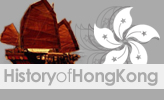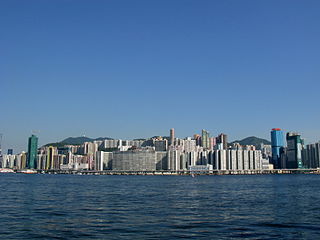Related Research Articles

The Royal Hong Kong Yacht Club is a Hong Kong watersports club for sailing and rowing including paddling.

North Point is a mixed-use urban area in the Eastern District of Hong Kong. Located in the northeastern part of Hong Kong Island, the area is named after a cape between Causeway Bay and Tsat Tsz Mui that projects towards Kowloon Bay.

The region of Hong Kong has been inhabited since the Old Stone Age, later becoming part of the Chinese Empire with its loose incorporation into the Qin dynasty. Starting out as a farming fishing village and salt production site, it became an important free port and eventually a major international financial center.
The Big Circle Gang or Big Circle Boys is a Chinese triad. In 2009, the Big Circle Boys were described as "one of the largest and most sophisticated criminal conspiracies" in Canada.
A Hong Kong returnee is a resident of Hong Kong who emigrated to another country, lived for an extended period of time in his or her adopted home, and then subsequently moved back to Hong Kong.

Waves of Chinese emigration have happened throughout history. They include the emigration to Southeast Asia beginning from the 10th century during the Tang dynasty, to the Americas during the 19th century, particularly during the California gold rush in the mid-1800s; general emigration initially around the early to mid 20th century which was mainly caused by corruption, starvation, and war due to the Warlord Era, the Second Sino-Japanese War and the Chinese Civil War; and finally elective emigration to various countries. Most emigrants were peasants and manual laborers, although there were also educated individuals who brought their various expertises to their new destinations.
Taiwanese Canadians are Canadians who carry full or partial ancestry from the East Asian country of Taiwan. There are over one hundred thousand Taiwanese who have gained citizenship or permanent residency status in Canada.

Shanghainese people in Hong Kong have played an important role in the region, despite being a relatively small portion of the Han Chinese population. "Shanghainese" is a term that refers to both the Wu Chinese language and the Han Chinese subgroups from the city of Shanghai and the peoples of the Jiangnan region in Hong Kong more broadly, particularly those with ancestral homes in parts of southern Jiangsu (Kiangsu), northern Zhejiang (Chekiang) and Anhui provinces.

Emigration from Hong Kong refers to the migration of Hong Kong residents away from Hong Kong. Reasons for migration range from livelihood hardships, such as the high cost of living and educational pressures, to economic opportunities elsewhere, such as expanded opportunities in mainland China following the Reform and Opening-Up, to various political events, such as the Japanese invasion of Hong Kong during the Second World War, the 1967 unrest, uncertainties leading up to the 1997 handover, and the 2019–2020 unrest. The largest community of Hong Kongers living outside of Hong Kong is in Mainland China, followed by the US, Canada and the UK.

Shanghainese people are an ethnic group of Shanghai Hukou descent or people who have ancestral roots from Shanghai. Most Shanghainese are descended from immigrants from nearby provinces of Zhejiang and Jiangsu. According to 1990 census, 85% of Shanghainese people trace their ancestry to Jiangsu and Zhejiang. Only a minority are Shanghai natives, those with ancestral roots in Shanghai.

Peter Lam Kin-ngok, GBS is a Hong Kong businessman and billionaire who has developed a reputation in Hong Kong's business, media, and entertainment industry, as well as in Asia's hospitality and food and beverage industries..
The British diaspora consists of people of English, Scottish, Welsh, Northern Irish, Cornish, Manx and Channel Islands ancestral descent who live outside of the United Kingdom and its Crown Dependencies.
Hongkongers, Hong Kongers, Hong Kongese, Hongkongese, Hong Kong citizens and Hong Kong people are demonyms that refer to a resident of Hong Kong, although they may also refer to others who were born and/or raised in the territory.
Hong Kong Canadians are Canadians who were born or raised in Hong Kong, hold permanent residency in Hong Kong, or trace their ancestry back to Hong Kong. In Canada, the majority of Hong Kong Canadians reside in the metropolitan areas of Toronto and Vancouver. Many Hong Kong Canadians continue to maintain their status as Hong Kong permanent residents.

Vietnamese boat people were refugees who fled Vietnam by boat and ship following the end of the Vietnam War in 1975. This migration and humanitarian crisis was at its highest in the late 1970s and early 1980s, but continued well into the early 1990s. The term is also often used generically to refer to the Vietnamese people who left their country in a mass exodus between 1975 and 1995. This article uses the term "boat people" to apply only to those who fled Vietnam by sea.

The Canadian diaspora is the group of Canadians living outside the borders of Canada. As of a 2010 report by the Asia Pacific Foundation of Canada and The Canadian Expat Association, there were 2.8 million Canadian citizens abroad. For comparison, that is a larger population than six of the ten Canadian provinces. More than 9% of all Canadian citizens live outside of Canada. That compares to 1.7% of Americans, 2.6% of Chinese citizens, 3.3% of French citizens, 4.3% of Australians, 9% of British citizens, and 21.9% of New Zealanders.
Mainland Chinese or mainlanders are Chinese people who live in or have recently emigrated from mainland China, defined as the territory governed by the People's Republic of China (PRC) except for Hong Kong, Macau, and the partly-PRC-controlled South China Sea Islands, and also excluding certain territories that are claimed by the PRC but not controlled, namely Taiwan a.k.a. the "Republic of China" (ROC), which is a state with limited recognition, and other associated territories that are ruled by Taiwan. The term also refers to historical groups of people of Chinese origin who immigrated to Hong Kong, Macau and Taiwan during the 20th century, especially in the context of specific historical events.
Canadians in China consist mainly of expatriates and students from Canada to the People's Republic of China. As of 2011 there are about 300,000 Canadians living in China.
Katarina Ammitzbøll is a Danish politician, who is a member of the Folketing for the Conservative People's Party. She was elected into parliament at the 2019 Danish general election.

The Health Bureau is a policy bureau of the Government of Hong Kong. They are responsible for the health portfolios. The agency was established on 1 July 2022. The current Secretary for Health is Professor Lo Chung-mau.
References
- ↑ Yacht people. (citizens of Hong Kong emigrating to Canada) (International) Economist (US), The, April, 1989 at findarticles.com